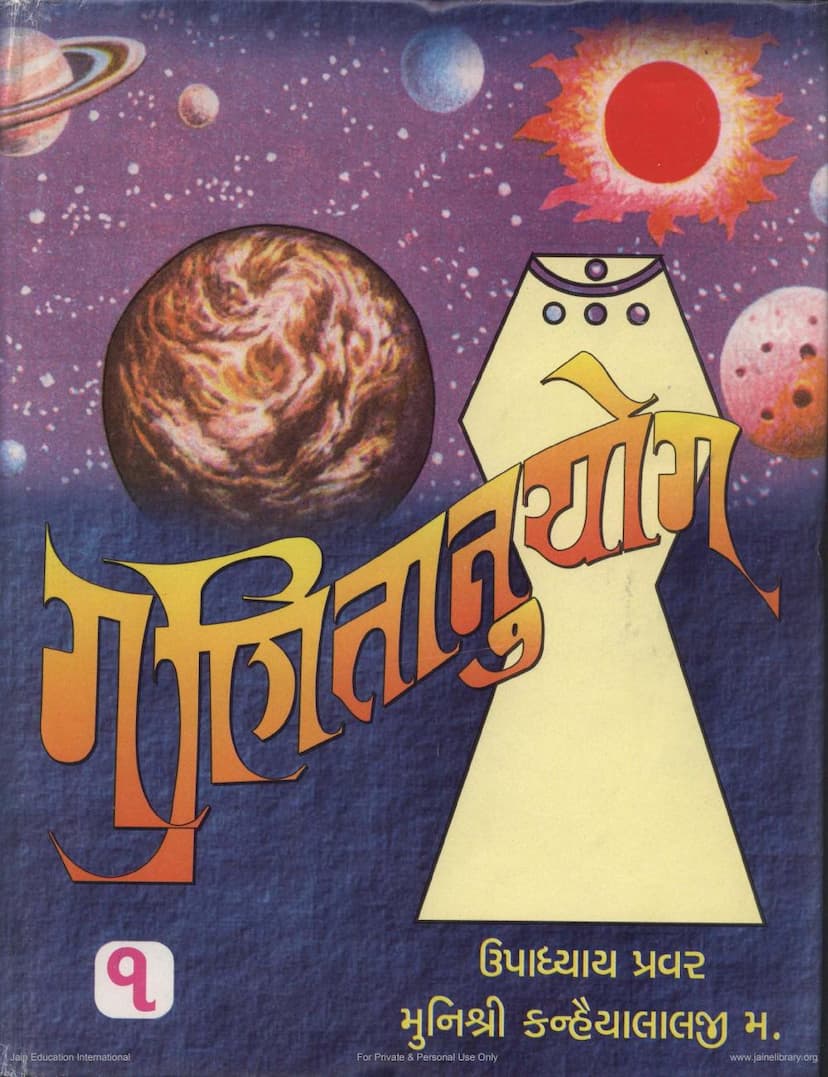Ganitanuyoga Part 1
Added to library: September 1, 2025

Summary
Here is a comprehensive summary of the Jain text "Ganitanuyoga Part 1" by Kanhaiyalal Maharaj:
Book Title: Ganitanuyoga Part 1 Author(s): Kanhaiyalal Maharaj Publisher: Agam Anuyog Prakashan Catalog Link: https://jainqq.org/explore/001946/1
This work, "Ganitanuyoga Part 1," is a meticulous compilation of geographical, astronomical, and cosmological information found within the Jain Agamas, presented with the original text and a Gujarati translation. It is authored by Upadhyaya Pravar Muni Shri Kanhaiyalalji Maharaj 'Kamal' and Colligated by Agam Rasik Sevabhavi Shri Vinay Muniji 'Vageesh'. Dr. Kanubhai V. Sheth (M.A., Ph.D.) has provided the Gujarati translation.
The book is published by Agam Anuyog Trust, Ahmedabad. It is dedicated to the memory of the author's parents, Shri Kanji Shivjibhai Mehta (Sangjibhai) and Shri Gulabben Kanji Khimjibhai Mehta, and supported by their son Mahendrakumar Kanji Mehta and his family. Various individuals and organizations have contributed to its publication, as listed in the acknowledgments.
Core Subject Matter:
The book falls under the Ganitanuyoga category of Jain literature, which deals with mathematics, cosmology, and scientific aspects as described in the Jain scriptures. Part 1 of Ganitanuyoga focuses on:
- Adholok (Lower World): The geographical and cosmological details of the realms below the middle world.
- Madhyalok (Middle World) up to the Oceans: It describes the regions of the middle world, extending to the various islands and oceans.
Key Concepts and Content:
The text aims to provide an authentic compilation of the rich geographical and astronomical material present in the Jain Agamas. It delves into the intricate descriptions of:
- Lok (Universe): The structure of the universe according to Jain cosmology, its division into Adholok, Madhyalok, and Urdhvalok. The concept of Lokpurush and Viratpurush from Vedic texts is also discussed and compared with Jain cosmology.
- Dravyalok (Substantial World): The six fundamental substances (dravyas) of Jainism—Jiva, Ajiva, Dharma, Adharma, Akasha, and Kala—are explained in relation to the Lok. The text details how these substances are distributed within the Lok and Aloka (non-universe).
- Kshetraloka (Spatial World): A detailed description of the various continents (dvipas) and oceans, their dimensions, shapes, and the beings that inhabit them. This includes:
- Jambudvipa: The central continent with Mount Meru at its core, surrounded by the Lavana Samudra (Salt Ocean). The text describes the Jambudvipa's structure, including its seven regions (varsas) like Bharatavarsha, Aivata, Mahavideha, etc., the year-based division of these regions (Karmabhumi and Akarmabhumi), the rivers flowing from the mountains, and the majestic presence of Mount Meru.
- Dvipasamudras: The text systematically describes the Dhātakikhanda dvipa, Pushkara dvipa (both Shvetambara and Digambara perspectives are presented), and subsequent island-oceans like Kshirasagar, Ghṛtavar, Ikshurasa, etc., up to the Svayambhuramana ocean which marks the boundary of the Lokālokā.
- Narakas (Hellish Realms): The seven lower hellish realms (Adholok) are described in meticulous detail, including their dimensions, the layers of earth (prithvi), the types of beings residing there, their lifespans, the nature of their suffering, and the various types of Naraka avasas (dwellings).
- Bhavanavasi Devas (Territorial Deities): The text describes the Abode of these deities, their respective Indras (chiefs) like Chamar, Bali, Dharan, Bhutananad, etc., their celestial palaces (bhavanas), their armies, councils, and the divine pleasures they experience.
- Kalaloka (Temporal Aspect): While this part primarily focuses on spatial descriptions, the cyclical nature of time is indirectly alluded to through concepts of karma and rebirth which necessitate these spatial realms.
- Bhāvaloka (States of Existence): The text touches upon the states of existence (bhāvas) of beings within these realms, especially concerning the hellish beings and their suffering, which is a consequence of their karma.
Structure and Content Organisation:
The book is structured to systematically cover the Adholok and Madhyalok up to the oceans. The detailed Table of Contents (pages 48-71) reveals the granular approach taken in describing each element of the cosmos, from the smallest units of space to the grandest celestial structures. It systematically breaks down the Lokā into its constituent parts, detailing the dimensions, shapes, inhabitants, and characteristics of each realm.
Key Features:
- Comprehensive Detail: The text is renowned for its precise and detailed cosmological descriptions, providing measurements in yojanas and other units as described in the Agamas.
- Agam-Based: It relies heavily on the original Jain Agamas, aiming for authenticity in its compilation.
- Comparative Approach: In sections discussing cosmology, the text often presents details from both Shvetambara and Digambara traditions, highlighting similarities and differences where relevant, though the primary focus seems to be on the compilation of universally accepted Jain cosmological principles.
- In-depth Explanation of Lokā: The book meticulously explains the Lokā, including its geographical features like mountains (Mandar), rivers (Ganga, Sindhu), islands (dvipas), oceans, and the specific locations of various celestial beings (devas) and hellish beings (narakas).
- Mathematical and Astronomical Elements: As part of Ganitanuyoga, it incorporates calculations and measurements related to the universe, providing a framework for understanding Jain cosmology from a numerical perspective.
Significance:
"Ganitanuyoga Part 1" serves as a foundational text for understanding the complex Jain cosmological framework. It is an essential resource for scholars, students, and practitioners of Jainism who wish to delve into the scriptural descriptions of the universe, its structure, and its inhabitants. The work of Muni Kanhaiyalalji Maharaj in compiling and clarifying this complex subject matter is highly regarded.
This summary covers the main aspects presented in the initial pages and the table of contents provided. The full text would offer an exhaustive exploration of these topics.